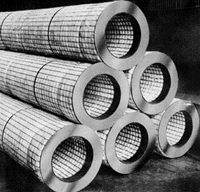
![]()
![]()
 |
|||
| Beltran's
Fume Coalescer - Fiber Bed Equipment:
Performance Small particles tend to be more visible because of the light scattering effect. Maximum scattering occurs when the particle size is about the order of the wavelength of light. In assessing the visibility of a mist plume, it is found that the predominant factor is the diameter of the droplets rather than their concentration. A small amount of sub-micron particles can stabilize a steam plume. The heavy opacity related with such plumes is often out of proportion to the concentration of particulates in the exhaust. Beltran Fume Coalescers employ both impingement and Brownian diffusion as collection mechanisms. The larger mist particles impinge directly on the fibers and coalesce, while the finer particles, which are in theory small enough to escape through the pores of the filter, do not do so in practice, because of their random or Brownian motion which causes them to deviate from the main direction of travel, eventually colliding with the fiber. For both these collection mechanisms, the finer the fiber in the fiber bed, the smaller the particle it can arrest. For a known particle size distribution, it is thus possible to design a fume coalescer for specific collection efficiency. The BELTRAN FUME COALESCER can also remove sub-micron soluble solid particles. For these applications, the candles are continuously irrigated. Principles of Operation: Beltran Fume Coalescers are designed to remove sub-micron particles with very high efficiency. The candles are usually tubular in shape. They are packed with glass fibers of carefully controlled gauge and of suitable chemical resistance to the particular working environment. Materials of construction for the supporting wire mesh screen and the filter housing are custom selected for each specific application. Gases containing mist and spray particles pass in a horizontal direction through the fiber bed. Fine mist particles are collected by impaction and diffusion mechanisms and cleaned gases emerge from the bed exiting from the top. The collected mist particles coalesce into a liquid film. The exhaust gases passing through the fiber bed move these films in a horizontal direction as the gravitational forces pull them in a downward direction. The collected liquids thus drain into the inner annular space and out through the bottom trapped drain legs. If the coalescer candles are installed in a special housing, the drain legs are immersed in the sump at the bottom of the housing to maintain a liquid seal. When the elements are suspended in the absorbing towers, individual seal cups are provided on the drain legs to maintain a liquid seal. Alternate designs with the gas flow from inside of the candle to the outside are also available. Applications Beltran Fume Coalescers are used in a variety of applications. In the chemical industry, acid mist generated in contact sulfuric acid plants, oleum storage tank vents, nitric acid plants, phosphoric acid plants, etc. can be very efficiently controlled using Beltran Fume Coalescers. The operation of the fume coalescer requires little, if any, maintenance. The pressure drop through the candle is less than 15 inches W-G. The Beltran Fume Coalescer is also used to control metal pickling fumes, fumes of sodium chloride, brine mists and acid mists In chlorine plants. The Beltran Fume Coalescer is also used for hydrocarbon emission control. Asphalt loading and storage areas, exhaust from textile tenter frames, plasticizer fumes from various heat curing operations and other condensable hydrocarbon emissions from various industrial processes use Beltran Fume Coalescers for efficient control of visible emissions. |
 Removes 99.5% of Sub-Micron Liquid or Soluble Solid Particles Benefits of Beltran Applications: Nitric Acid Textile Processing Plasticizers Metal Pickling Chlorine Plants Hydrocarbon Mists Oleum Storage Tank Vents Asphalt Loading & Storage Areas Bacteria & Virus Removal Compressed Gases |
||